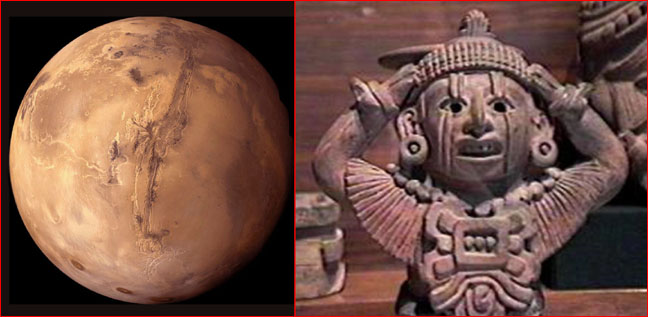Thanks all for this new informative session!
Very interesting, thanks for asking!
I could find this on Thunderbolts.info and I thought that the name of this valley on Mars as it is Marinaris is pretty "sufficient" as it could directly refer to water and ocean mentioned here:
Laura said:...
(Pierre) Let's shift to a more cheerful topic: cometary bombardments. So we discussed the death of the woolly mammoths due to a cometary bombardment. I would like to know about the transfer of water from Mars to planet Earth, when did it occur relative to this cometary bombardment? How many years before, how many years after?
A: Within 40 years more or less.
Q: (Pierre) So cometary bombardment, and then Mars water transfer?
(L) And how did that happen?
A: Electric arc of cosmic proportions.
Q: (Pierre) You mean the water transfer? Yeah, that's the arcing. The plasma connection between Earth and...
(L) Was this the same event that left that gigantic scar on Mars? (I don’t know how anybody can look at that scar and not get the willies!)
A: Yes.
Q: (Joe) How close was Mars? Water can be...
(Pierre) It was closer because...
(Joe) ...transferred through hundreds of millions of miles of space?
A: Mars was much closer temporarily. Tales of gods fighting in the sky and castration of Chronos relate to this event.
...
Very interesting, thanks for asking!
I could find this on Thunderbolts.info and I thought that the name of this valley on Mars as it is Marinaris is pretty "sufficient" as it could directly refer to water and ocean mentioned here:

Pictured above on the left: the planet Mars as photographed by Mariner 4 in 1965,
revealing its hemispheric scar (Valles Marineris) for the first time.
On the right: the Aztec god Xipe, displaying his deeply scarred face.
Apr 12, 2005
Lightning-Scarred Gods and Monsters
Why would we present these two images side by side? We do so because in the sciences the inertia of prior beliefs has excluded questions that now demand open-minded consideration. Scientific inquiry flourished on a ground of skepticism about ancient “magic and superstition”. It seemed obvious that primitive mythology and religion could only obstruct the quest for knowledge. But now a new possibility has emerged—the possibility that even the most “irrational” myths hold a key to planetary history.
According to David Talbott and Wallace Thornhill, the mythic “thunderbolts of the gods” provide a bridge between historical investigation and plasma science. The two authors contend that the heaven-altering “thunderbolt”, so prominent in the myths of gods and heroes, has preserved a human memory of planetary upheaval. But these myths will not be comprehended by referring them to events in our sky today. Rather, such myths take us back to a time when planets moved in close congregation through a rich medium of electrified plasma. Our ancestors, they tell us, lived beneath an alien sky, in the mythic “age of gods and wonders”.
Many cultures recall a great hero, warrior, or giant struck down by a “lightning” weapon (sword, spear, etc.) and scarred by the deep gash or wound it left on his forehead, cheek, or thigh. In his investigation of this worldwide theme, Talbott called this “the Scarface motif”.
When referred to the behavior of celestial bodies today, the theme can only appear preposterous. But there is another way of seeing such traditions. The authors identify the earliest astronomical archetype of the warrior-hero, in both his glorious and his terrible aspects, as the planet Mars. They say that the planet appeared in the ancient sky as a towering and frightful form. Therefore, the stark Mariner image of the scarred planet and the carved image of the scarred god may reveal two aspects of the same secret. In the course of transmission and cultural assimilation, most ancient gods lost all connection to the “planets” of the later, stable, and predictable solar system. But the earlier astronomical traditions offer the investigator a window to original meanings.
“Scarface” was the name of a legendary Blackfoot Indian warrior, also called “Star Boy”. A close counterpart was the Pawnee warrior Morning Star—identified as the planet Mars (not Venus, as some have supposed). On the other side of the world, Greek mythology described various heroes and rogues (one and the same archetype) struck down by a lightning-weapon. When Ares, the planet Mars, was wounded in battle, he roared with the shout of a thousand warriors and rushed to Zeus to display the deep gash. So too, the hero Heracles, also identified with Mars, was remembered for the deep wound on his “hip-joint”. The monster Typhon, vanquished by Zeus, was the “lightning scarred” god, as was the giant Enceladus. Hindu myths speak of the deep scar on the head of the warrior Indra, god of the cosmic thunderbolt, and a thunderbolt was said to have scarred the monstrous giant Ravena.
Without the benefit of a much broader, cross cultural investigation, any suggestion that the hemispheric scar on Mars was left by an interplanetary lightning bolt, or that it was this event that provoked the “Scarface“ theme, will only invite incredulity. But as the roots of the myths are brought out and the underlying integrity revealed, the improbable becomes the more likely. Rigorous cross-cultural investigation can only underscore our challenge to prior scientific beliefs. For the connection suggested here becomes meaningful only if the events occurred within human memory. Then the scientific prejudice in favor of an uneventful solar system can no longer be maintained.
By freeing ourselves from the inertia of belief, we invite investigation of questions that Martian exploration has left unanswered. What event carved the Valles Marineris? Why does this chasm compare so favorably to electrical discharge scarring? And how does other electrical activity on Mars (noted in prior Pictures of the Day) affect our perception of the Red Planet in the ancient myths?

 An event of those proportions is almost unimaginable.
An event of those proportions is almost unimaginable. 
